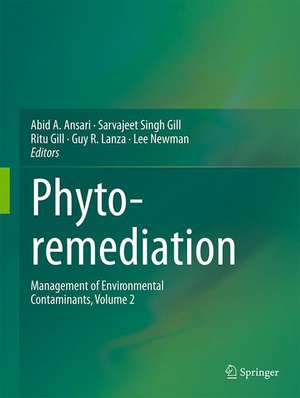Phytoremediation: Management of Environmental Contaminants, Volume 2
Editat de Abid Ali Ansari, Sarvajeet Singh Gill, Ritu Gill, Guy R. Lanza, Lee Newmanen Limba Engleză Hardback – 25 mar 2015
This book covers state of the art approaches in Phytoremediation written by leading and eminent scientists from around the globe. Phytoremediation: Management of Environmental Contaminants, Volume 1 supplies its readers with a multidisciplinary understanding in the principal and practical approaches of phytoremediation from laboratory research to field application.
| Toate formatele și edițiile | Preț | Express |
|---|---|---|
| Paperback (1) | 1230.84 lei 43-57 zile | |
| Springer International Publishing – 27 iun 2018 | 1230.84 lei 43-57 zile | |
| Hardback (2) | 980.47 lei 22-36 zile | |
| Springer International Publishing – 25 mar 2015 | 980.47 lei 22-36 zile | |
| Springer International Publishing – 4 oct 2016 | 1237.14 lei 43-57 zile |
Preț: 980.47 lei
Preț vechi: 1195.70 lei
-18% Nou
Puncte Express: 1471
Preț estimativ în valută:
187.62€ • 196.38$ • 156.15£
187.62€ • 196.38$ • 156.15£
Carte disponibilă
Livrare economică 10-24 martie
Preluare comenzi: 021 569.72.76
Specificații
ISBN-13: 9783319109688
ISBN-10: 3319109685
Pagini: 400
Ilustrații: XV, 366 p. 73 illus., 42 illus. in color.
Dimensiuni: 210 x 279 x 22 mm
Greutate: 1.45 kg
Ediția:2015
Editura: Springer International Publishing
Colecția Springer
Locul publicării:Cham, Switzerland
ISBN-10: 3319109685
Pagini: 400
Ilustrații: XV, 366 p. 73 illus., 42 illus. in color.
Dimensiuni: 210 x 279 x 22 mm
Greutate: 1.45 kg
Ediția:2015
Editura: Springer International Publishing
Colecția Springer
Locul publicării:Cham, Switzerland
Public țintă
ResearchCuprins
Improved Quality of Abattoir Wastewater Through Phytoremediation.- Phytoremediation of Contaminated Waters To Improve Water Quality.- On-Site And Full-Scale Applications of Phytoremediation To Repair Aquatic Ecosystems With Excess Metals.- Phytoremediation of Eutrophic Waters.- Phytoremediation of Water And Wastewater: On-Site And Full-Scale Applications.- Interaction of Algae-Bacteria Consortia: A New Application of Heavy Metals Bioremediation.- Heavy Metals Phytoremediation From Urban Waste Leachate By The Common Reed (Phragmites Australis).- Cyanobacteria as Potential Options For Wastewater Treatment.- Phytoremediation Using Rhizobia.- Phytoremediation of Heavy Metals: The Use of Green Approaches To Clean The Environment.- Phytoremediation Using Leguminous Plants: Managing Cadmium Stress With Application of Arbuscular Mycorrhiza (Am) Fungi.- Phytoremediation of Copper-Contaminated Soil.- Phytoremediation of The Metalloid Selenium In Soil And Water.- Phytoremediation Using Microbial Communities: I.- Phytoremediation Using Microbial Communities: Ii.- Effects of Bio-Solids On The Transpiration Rate of Rainbow Pink (Dianthus Chinensis) Grown In Cadmium-Contaminated Soils.- Phytoremediation And The Electrokinetic Process: Potential Use For The Phytoremediation of Antimony And Arsenic.- Chromium Phyto-Transformation In Salt Marshes: The Role of Halophytes.- Molecular Mechanisms And The Phytoremediation of Heavy Metals From Coastal Water.- Lichens as An Alternative Biosorbent: A Review.- Phytoremediation In Constructed Wetlands.- Phytoremediation Using Algae And Macrophytes: I.- Phytoremediation Using Algae And Macrophytes: Ii.- Phytoremediation To Remove Metals/Metalloids From Soils.- Phytoremediation Using Terrestrial Plants.- Phytoremediation And Necrophytoremediation of Petrogenic Hydrocarbon-Contaminated Soils.- An Integrated Electrochemical-Phytoremediation Process For The Treatment of Industrial Wastewater.- Metal Accumulation Capability of Weeds And Their Utilization In Phytoremediation Technology.
Notă biografică
Dr. Abid A Ansari, M.Sc., Ph.D
Department of Biology, Faculty of Science, University of Tabuk
Tabuk, Kingdom of Saudi Arabia
Dr. Sarvajeet Singh Gill, M.Sc. (Gold medal), M.Phil., Ph.D, Dr. Ritu Gill, Ph.D
Stress Physiology and Molecular Biology Lab, Centre for Biotechnology,
MD University, Rohtak 124 001,
Haryana, India
Dr. Guy R. Lanza, Ph.D.
Aquatic Ecology and Microbiology
Department of Environmental and Forest Biology
SUNY – College of Environmental Science and Forestry
Syracuse, NY
and
Dr. Lee Newman, Ph.D
Biotechnology and Phytoremediation
Department of Environmental and Forest Biology
SUNY - College of Environmental Science and Forestry
Syracuse, NY
Department of Biology, Faculty of Science, University of Tabuk
Tabuk, Kingdom of Saudi Arabia
Dr. Sarvajeet Singh Gill, M.Sc. (Gold medal), M.Phil., Ph.D, Dr. Ritu Gill, Ph.D
Stress Physiology and Molecular Biology Lab, Centre for Biotechnology,
MD University, Rohtak 124 001,
Haryana, India
Dr. Guy R. Lanza, Ph.D.
Aquatic Ecology and Microbiology
Department of Environmental and Forest Biology
SUNY – College of Environmental Science and Forestry
Syracuse, NY
and
Dr. Lee Newman, Ph.D
Biotechnology and Phytoremediation
Department of Environmental and Forest Biology
SUNY - College of Environmental Science and Forestry
Syracuse, NY
Textul de pe ultima copertă
Volume two of this dual volume series includes additional examples of the use of green plants and their associated communities to remove, degrade, or stabilize contaminants entering the air, water and soil of a multitude of ecosystems. The chapters in this volume provide additional examples that illustrate how phytoremediation applications can serve as one of several useful components in the overall management and control of contaminants while using relatively low cost solar driven physiological and biochemical mechanisms common in most plants. This text also has the added value of providing remediation options that offer minimal disruption to the ecosystem or habitat under repair.
Phytoremediation: Management of Environmental Contaminants, Volume 2 presents its readers with new insights into the advantages and disadvantages of using phytoremediation to manage the continuing threat of ecosystem degradation resulting from the interaction of contaminants and climate change.
Phytoremediation: Management of Environmental Contaminants, Volume 2 presents its readers with new insights into the advantages and disadvantages of using phytoremediation to manage the continuing threat of ecosystem degradation resulting from the interaction of contaminants and climate change.
Caracteristici
Written by the world's leading authorities on phytoremediation Contains the latest case studies and applied techniques of phytoremediation Elucidates ground breaking methods for the production of plants to degrade or absorb the effects of pollutants












